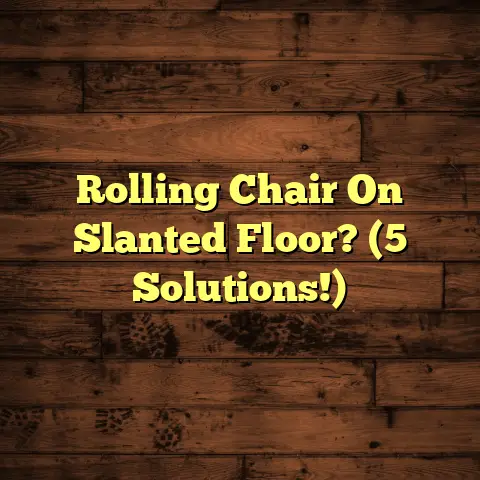Level Concrete Floors Cheaply? (Under $100!)
Have you ever dreamed of transforming your uneven concrete floors into a perfectly level surface without breaking the bank? I know I have!
It’s a common desire for homeowners and DIY enthusiasts alike. After years in the flooring business, I can tell you that level floors are more than just aesthetically pleasing.
They’re crucial for the functionality of your home and can even save you money on long-term maintenance. Let’s dive into how you can achieve this without emptying your wallet.
Section 1: Understanding the Importance of Level Floors
Uneven concrete floors can be a real headache. Think about it:
- Furniture Wobbles: That beautiful antique table? It’s going to rock and roll on an uneven surface.
- Flooring Installation Nightmares: Trying to lay tile, laminate, or even carpet over an uneven concrete floor? Forget about it! You’ll end up with a bumpy, unprofessional-looking mess.
- Property Value: Potential buyers notice these things. Uneven floors can detract from the overall value of your home.
I’ve seen it all. Settling foundations, water damage, and just plain old poor construction can all lead to uneven floors.
According to the American Society of Civil Engineers (ASCE), foundation settlement is a leading cause of structural issues in homes, and uneven floors are often the first visible sign.
Section 2: Exploring Budget-Friendly Solutions
Now, let’s get to the good stuff: how to level those concrete floors without spending a fortune. I’m talking under $100!
Here are a few methods I’ve used and seen success with over the years. Remember, prices can vary depending on your location and the specific products you choose.
Method 1: Self-Leveling Compound
What is it?
Self-leveling compound is a cement-based mixture that, when poured, flows and spreads out to create a smooth, level surface. It’s like magic… well, almost.
Estimated Cost:
A 50 lb bag of self-leveling compound typically costs between $30 and $50. For smaller areas, you might only need one bag, keeping you well within budget.
Materials Needed:
- Self-Leveling Compound (e.g., Ardex Feather Finish, Henry 554 LevelPro Self-Leveling Underlayment) [$30 – $50 per 50 lb bag]
- Mixing Bucket (5-gallon) [$5 – $10]
- Drill with Mixing Paddle [$20 – $40 (if you don’t already have one, consider renting)]
- Spiked Roller [$15 – $25]
- Measuring Pitcher [$5 – $10]
- Water
Step-by-Step Instructions:
- Prep the Surface: This is crucial! Clean the concrete thoroughly. Remove any debris, dirt, grease, or old adhesive. I usually use a concrete degreaser and a scrub brush.
- Prime the Floor: Apply a concrete primer to ensure the self-leveling compound bonds properly. This usually costs around $15-$20 per quart.
- Mix the Compound: Follow the manufacturer’s instructions precisely. Too much or too little water can ruin the mix. Use a drill with a mixing paddle for best results. The consistency should be like a thin pancake batter.
- Pour and Spread: Pour the mixture onto the floor, starting in the deepest areas. Use a gauge rake or trowel to help spread it evenly.
- Use a Spiked Roller: This helps release any trapped air bubbles and ensures a smooth finish.
- Let it Dry: Allow the compound to dry completely according to the manufacturer’s instructions. This can take anywhere from 24 to 72 hours.
Pro Tip: Work in small sections to prevent the compound from drying before you can spread it evenly.
Method 2: Using a Floor Leveling Overlay
What is it?
A floor leveling overlay is a thin layer of cement- based material applied to the existing concrete floor. It’s designed to smooth out minor imperfections and create a level surface.
Estimated Cost:
A 50 lb bag of floor leveling overlay typically costs between $25 and $40.
Materials Needed:
- Floor Leveling Overlay (e.g., Quikrete Self-Leveling Floor Resurfacer) [$25 – $40 per 50 lb bag]
- Mixing Bucket [$5 – $10]
- Drill with Mixing Paddle [$20 – $40 (if you don’t already have one, consider renting)]
- Trowel [$10 – $20]
- Water
Step-by-Step Guide:
- Clean the Surface: Just like with self-leveling compound, a clean surface is essential.
- Mix the Overlay: Follow the manufacturer’s instructions for mixing the overlay. The consistency should be similar to a thick paint.
- Apply the Overlay: Use a trowel to apply the overlay to the floor, focusing on low spots and uneven areas.
- Smooth the Surface: Use the trowel to smooth out the overlay and create a level surface.
- Let it Dry: Allow the overlay to dry completely before walking on it or installing flooring. This usually takes 24 to 48 hours.
Pro Tip: For a smoother finish, dampen the trowel slightly before smoothing the overlay.
Method 3: Patching Compound for Smaller Areas
What is it?
Patching compound is a quick and easy solution for filling in small holes, cracks, and low spots in concrete floors.
Estimated Cost:
A small container of patching compound typically costs between $10 and $20.
Materials Needed:
- Patching Compound (e.g., DAP Concrete Patch, Sakrete Concrete Patch) [$10 – $20 per container]
- Trowel or Putty Knife [$5 – $10]
- Water (if required by the patching compound)
Comprehensive Guide:
- Clean the Area: Remove any loose debris from the area you’re patching.
- Mix the Compound: If required, mix the patching compound with water according to the manufacturer’s instructions.
- Apply the Compound: Use a trowel or putty knife to apply the compound to the low spot or crack.
- Smooth the Surface: Smooth the compound to match the surrounding surface.
- Let it Dry: Allow the compound to dry completely before walking on it or installing flooring.
Pro Tip: For deeper holes, apply the patching compound in layers, allowing each layer to dry before applying the next.
Method 4: Utilizing Shims or Wood Filler
What is it?
This method is best for localized leveling, especially when dealing with slight unevenness under furniture or appliances.
Estimated Cost:
Wood shims and wood filler are very inexpensive, usually costing less than $10.
Materials Needed:
- Wood Shims [$5 – $10]
- Wood Filler [$5 – $10]
- Utility Knife or Saw (for trimming shims)
- Level
Detailed Process:
- Identify Uneven Areas: Use a level to identify the areas that require shimming.
- Insert Shims: Carefully insert shims under the furniture or appliance until it is level.
- Trim Shims: Use a utility knife or saw to trim any excess shim material.
- Apply Wood Filler (Optional): If desired, apply wood filler to any gaps around the shims for a more seamless look.
- Sand and Paint (Optional): Once the wood filler is dry, sand it smooth and paint it to match the surrounding surface.
Pro Tip: For larger gaps, consider using a combination of shims and wood filler for a more stable and aesthetically pleasing result.
Section 3: Tools of the Trade
Here’s a list of tools you’ll likely need for these projects, along with estimated costs:
| Tool | Estimated Cost | Where to Find Affordable Options |
|---|---|---|
| Mixing Bucket | $5 – $10 | Local hardware store, online retailers |
| Drill with Paddle | $20 – $40 | Harbor Freight, Amazon (consider renting) |
| Trowel | $10 – $20 | Local hardware store, online retailers |
| Spiked Roller | $15 – $25 | Online retailers, flooring supply stores |
| Putty Knife | $5 – $10 | Local hardware store, dollar stores |
| Level | $10 – $30 | Local hardware store, online retailers |
| Utility Knife/Saw | $5 – $15 | Local hardware store, dollar stores |
| Measuring Pitcher | $5 – $10 | Dollar store, kitchen supply store |
Remember, you don’t always need the most expensive tools. Look for affordable options at discount stores or consider renting larger equipment like a drill with a mixing paddle.
Section 4: Safety Precautions and Best Practices
Working with concrete and leveling compounds can be messy and potentially hazardous if you’re not careful. Here are some essential safety measures:
- Wear Safety Glasses: Protect your eyes from dust and debris.
- Wear Gloves: Concrete and leveling compounds can irritate your skin.
- Wear a Dust Mask: Avoid inhaling concrete dust, which can be harmful to your lungs.
- Ventilate the Area: Open windows and doors to ensure proper ventilation.
- Follow Manufacturer’s Instructions: Always read and follow the manufacturer’s instructions for mixing and applying leveling compounds.
Here are some best practices for a successful leveling job:
- Surface Preparation is Key: I can’t stress this enough! A clean, properly prepared surface is essential for a good bond.
- Mix Thoroughly: Ensure the leveling compound is mixed thoroughly to avoid lumps and inconsistencies.
- Don’t Overwater: Adding too much water can weaken the compound and affect its leveling ability.
- Allow Proper Drying Time: Be patient! Allow the leveling compound to dry completely before walking on it or installing flooring.
Section 5: Case Studies and Real-Life Examples
I’ve seen so many homeowners successfully level their floors on a budget. Here are a couple of quick examples:
- Sarah’s Sunken Living Room: Sarah had a sunken living room floor due to foundation settling. She used self-leveling compound to raise the floor and create a level surface for new laminate flooring. She spent about $80 on materials and was thrilled with the results.
- John’s Garage Makeover: John’s garage floor was riddled with cracks and low spots. He used patching compound to fill in the cracks and a floor leveling overlay to smooth out the surface. He spent about $60 and now has a smooth, level garage floor perfect for his woodworking projects.
These are just a couple of examples, but they demonstrate that it is possible to achieve level concrete floors without breaking the bank.
Conclusion
So, can you level concrete floors cheaply? Absolutely! With a little bit of elbow grease, some affordable materials, and the right techniques, you can transform your uneven floors into a smooth, level surface.
Don’t let uneven floors hold you back from creating the home of your dreams. Take action, start your flooring project, and enjoy the satisfaction that comes with a DIY achievement!





